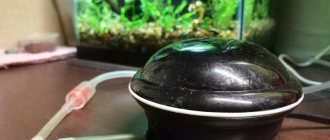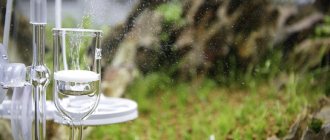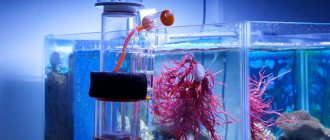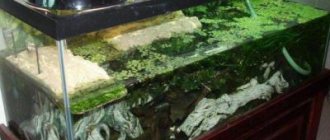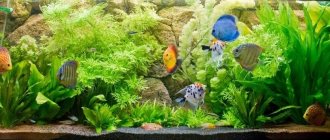03/21/2019Aquarium0
The use of a compressor in an aquarium is explained by the need to supply air to the water and saturate it with oxygen. In most cases, a deficiency in the gas mixture is caused by excessively high liquid temperatures due to the action of room heaters. If you do not use a device for additional air supply, the likelihood of fish death under such conditions increases significantly. According to natural science laws, as water cools, the limit of oxygen saturation increases, therefore, its best supply will occur in reservoirs with cooled liquid.
- 1 Why do you need a compressor in an aquarium?
- 2 Mr. Tail recommends: the main types of professional compressors 2.1 Pump for an aquarium
- 2.2 Mini compressors
Content recommendations
Aquariums are often installed in places where large numbers of people gather.
In order for the microclimate to remain optimal, the compressor must be constantly running. If an electromagnet was provided during the manufacture of the device, then the compressor should be hidden so that noise does not interfere. You can hide it in a pipe that will run under the aquarium. You'll have to buy an air duct. It is needed to transfer air to the aquarium. This will allow the system to function optimally. The compressor power must correspond to the displacement of the aquarium. It is necessary that the air flow is soft and moderate. For this purpose, the displacement is calculated. Even for large engine volumes, 12 W will be enough.
If the air cooler is too powerful, it can cause aquarium inhabitants to become ill or die. A high power motor will create strong water circulation. This will disrupt all the natural and life processes of the fish. If there is a lot of algae in the aquarium, then the compressor should be turned off during the day. Otherwise, you can create excess oxygen.
Pump assembly parts
To assemble the medium pressure air pump housing you will need:
- a board and a shovel handle for a stand and pump handle;
- water socket with a diameter of 16 mm and an internal thread of 0.5 mm;
- brake hose from a gazelle;
- rivet;
- nipple cap.
To assemble the cylinder:
- adapter for polypropylene pipe with a diameter of 20 mm. External thread of the adapter – 0.5 mm;
- polypropylene pipe for hot water with a diameter of 20 mm;
- pipe plug;
- aluminum tube – 12 mm;
- two nipples from a tubeless tire.
You will also need a scalpel, sandpaper, drill, epoxy glue, fitting.
DIY aquarium compressor
Let's look at how you can make a pump for an aquarium with your own hands. For this we will need the following materials:
- rubber chamber;
- pump (manual or pedal);
- three-way valve (tee);
- a plastic tube with a clip (for example, from a medical dropper).
So, to make a pump aeration device, a tube should be attached to each outlet of the tee: the first of them will go to the pump, the second to the rubber chamber, and the third (for which a clamp will be required) will be used as an air supply hose.
The end of the last tube is firmly plugged with a stopper, in front of which several small holes are pierced directly in the tube (with an awl or a needle). These openings are intended for the exit of air masses.
Important! All connections must be reliable and tight. The aerator assembled in this way will function according to the following principle
Initially, a tube is used to collect air, which leads from the pump to a rubber chamber
The aerator assembled in this way will function according to the following principle. Initially, a tube is used to collect air, which leads from the pump to a rubber chamber.
When air fills this chamber to capacity, the tube will cease to perform its function, but another one will take its turn to function - leading from the chamber to the exit of the device. Using the clamp, you can adjust the speed at which the air comes out. It is advisable to make the air flow as slow as possible.
Aquarium with fish
Quiet compressor
Now let's talk about how you can modify a factory product in order to make it almost silent. For this we may need:
- Styrofoam;
- sponge for washing dishes;
- foam rubber, etc.
First of all, you should open the compressor housing and study its structure, as well as the arrangement of all elements. In a particular case, the reason for the increased noise level emanating from a vibration compressor device may be the contact of the membrane with another part of the device.
To eliminate this defect, it is enough to carefully file or cut out the area that interferes with the free movement of the membrane.
It is also possible to reduce noise production by placing a foam sponge under the device, which will help absorb sound. You can build a soundproofing foam box for the compressor or wrap it in foam rubber.
How to install a compressor in an aquarium? (air compressor for aquarium)
The air compressor in the aquarium must also be installed correctly. To do this, you should take into account some nuances.
- Connection must begin with choosing a location. It can be placed both inside the container and on the lid of the aquarium or next to it.
- Internal installation can be carried out either above the surface of the water, or with partial or complete immersion. In the latter case, the installation of a return valve becomes mandatory.
- It makes sense to install an aquarium heater next to the compressor. This proximity will allow you to quickly mix heated and cold water.
Important! Do not forget to also systematically clean the device and aerate it. Its clogging reduces performance and can lead to failure.
In addition, a dirty device operates with a high level of noise.
DIY air atomizer for an aquarium
An important element of the compressor design is the atomizer. It is a nozzle on the tube of the device, with the help of which air comes out of it in the form of small bubbles. You can purchase a ready-made sprayer at a pet supply store, or you can make it yourself.
By the way, you already know how to create a simple atomizer - we mentioned this while talking about making a compressor. The function of the small holes at the end of its supply tube is precisely to atomize air.
Advice! If a tube with holes is placed under the ground along the back wall of the aquarium, in addition to its main function, it will also perform a decorative one, creating an almost meditative continuous flow of tiny bubbles.
Spray nozzles can also be made from any porous materials that will not release harmful substances into the water. Such materials can be abrasive stone or certain types of wood. Before creating a spray, they must be thoroughly boiled in water. This nozzle must be perfectly sized to the outlet tube.
Now you know how to make a compressor for an aquarium with your own hands. In addition, the recommendations and tips outlined in this article will help you refine the design of a product purchased at a pet store.
Tools and materials
At home, you can build an air blower for an aquarium yourself using available materials. To create a conventional mechanical air compressor you will need:
- a car pump (a hand pump from a bicycle will do);
- silicone tube (an excellent solution is an IV tube);
- 3-way valve;
- a mechanism for squeezing the tube (you can use a clamp from a dropper);
- clamps;
- car camera (for a small tank up to 80 liters, a soccer ball is enough).
For a battery-powered device with a cooler you will need:
- not very large PET bottle;
- a small electric motor (a cooler from a computer fan is perfect);
- IV tube;
- glue (it is advisable to use instant action);
- wiring;
- batteries;
- battery pack (a box for storing batteries with an on/off button).
To make a 4-chamber mini air compressor, you will need the following tools and materials:
- PET bottle with a large neck – 4 pieces;
- round balloon – 4 pieces;
- elastic bands - 4 pieces;
- 5 microgram syringe – 4 pieces;
- plastic measuring 10x15 centimeters - 1 piece;
- PET bottle cap – 1 piece;
- a piece of plastic measuring 5x5 centimeters - 1 piece;
- paper clips – 5 pieces;
- dropper – 1 piece;
- gearbox with motor – 1 piece;
- switch – 1 piece;
- battery – 1 piece;
- wires – 2 pieces;
- electric soldering iron;
- knife;
- Super glue;
- hot melt adhesive.
Step-by-step compressor installation
Before purchasing a compressor, make sure it matches your electrical requirements. Detailed requirements and algorithm for assembling the device are always indicated in the instructions. Read them carefully and, if anything remains unclear, ask your consultant how to install the compressor correctly. Remember that a compressor that is too powerful can create uncomfortable conditions for the fish; a powerful current can only be eliminated by clamping the hose. But why overpay for electricity and listen to noise? This solution can also cause the engine to overheat. Our information article will help you choose the right aerator.
Aerator for live bait
Subscribe to the author
Follow the author if you like his publications. Then you will receive notifications about his new posts.
You can always unsubscribe from notifications in the author's profile.
The article applies to printers:
Many of us love fishing, some prefer a feeder, some donks, some a float or a spinning rod, and there are those who fish with live bait. Personally, I prefer not to torture the fry, but once I had to move a long distance, and aquarium fish cannot be released into our ponds, I had to look for a solution. And so it was just found among fishermen - namely: an aerator for live bait.
After a certain period of time, talking with a friend, he complained that it would not be possible to keep the fry alive for a long time, and he simply did not have time to catch fresh ones every time. Subtly hinting at the need for an aeration system, but one that you can take with you and doesn’t take up much space. Then I remembered about the mobile aerator. Previously, I had the opportunity to use these once, and this one was very weak and ran on large batteries (type D, it seems).
I decided to try to model something myself. Realizing that the budget was unlikely to be less than that of something produced in China at a factory and sent a couple of months later, I came to the conclusion that we had to go for quality. By quality I mean power and ease of air flow regulation.
Operating rules
Aerators, better known as compressors, do not have a complex layout by design
After installation, a high-quality unit works like a clock, but still, when using it, you should pay attention to some subtleties and nuances
It is necessary to pay attention to the cooling of the aerator. Of course, if the device is installed correctly and used according to the instructions, there cannot be overheating in the system
And he won’t need any time to rest. If suddenly the temperature of the unit begins to exceed the norm, the device must be sent for repair. Experienced aquarists can try to repair the compressor themselves, as possible causes of the malfunction may be the absence of a check valve or water getting into the system.
It is necessary to carefully read the issue of round-the-clock operation of the aerator. Most aquarists turn off the power supply at night. But at night, algae and other plants growing in the aquarium stop producing oxygen, but continue to release carbon dioxide. If it becomes necessary to disconnect the compressor from the power supply, it is best to do this during the day, when the oxygen from the disconnected aerator is naturally compensated by the plants. These facts help save the life of the aquarium world. Fish cannot live for long without air.
Duration of non-stop operation of the unit. Typically, compressors are turned off for a short period of time, for example, when the aquarium needs to be cleaned. But in general, the device can work without rest for a long time, especially if the device is of high quality and is in excellent condition. To increase the reliability of the aerator, a check valve should be installed.
From the information presented above, it becomes clear that even the operating rules for compressors do not have serious requirements. A high-quality aerator should work like a clock. It is not recommended to frequently turn off and on a perfectly functioning device; the main thing is that during a planned disconnection from the network, do not leave living organisms of the aquarium world without oxygen for a long time.
To see why an aquarium needs a compressor, see the following video.
What affects the amount of oxygen?
List of properties that affect oxygen concentration:
- Water temperature – warm water is an indicator of a large amount of oxygen, and vice versa. Temperatures above normal affect the acceleration of vital processes in fish. Because of this, their need for oxygen increases when its concentration in water decreases. This problem is solved by intensive aeration.
- Plants can successfully produce oxygen without filters. But you need to keep in mind that at night they use it and create carbon dioxide. It turns out that during the day, due to the work of plants, fish feed on oxygen, and at night all living organisms have to fight for air.
- Snails and other creatures can affect the amount of oxygen in the tank. Bacteria perform the same task. Bacteria's consumption of oxygen is important because it is beneficial. If there is too much organic waste, the number of bacteria will increase and they will begin to consume more oxygen. The amount of waste also depends on how many snails are in the aquarium.
Device placement
Making the mechanism is quite simple. First you need to choose a location. You can place it inside the container, above the surface, or outside. Hoses with a sprayer are placed at the bottom. It is not necessary to provide fastening; you can press down the hose with a heavy stone or shell.
For the tube, it is better to choose silicone or any other elastic rubber. It needs to be able to easily withstand deformation and not crack. The service life of the device depends on this element.
The tube must be inert and not release any harmful substances when exposed to water. If you don’t have silicone, it’s better to buy it separately at a pet store. You can also use a hose from a drip.
Advice from experienced owners
To avoid unforeseen situations, experienced fish holders recommend the following to beginners in the field of aquarium keeping:
- Replace compressor components, taking into account natural wear and tear.
- With prolonged use, the device becomes more quickly contaminated, as a result of which the holes become clogged and oxygen is supplied in insufficient quantities. You can eliminate the problem by thoroughly cleaning the device.
- The aerator hoses or tubes are periodically checked for leaks.
- In order not to risk the well-being of the fish, experienced water enthusiasts recommend keeping a spare mini-aerator in case of breakdown.
An aquarium compressor is a convenient device designed to preserve and protect the life of fish and shellfish at home. Thanks to the use of an aerator, aquarists can admire colorful fish and lush green plants in their own pond every day.
Aquarium compressor
An aerator for an aquarium is no less necessary than for a reservoir of any size. After all, with a relatively small number of plants, the water in the aquarium is not sufficiently saturated with oxygen.
And as a result of the vital activity of various aquarium organisms, a lot of carbon dioxide enters the water. In this case, an aerator is simply necessary.
A standard compressor consists of a hose, pump and sprayer. Tiny air bubbles are distributed throughout the water. The principle applies here - the smaller they are and at the same time there are many of them, the better.
Among the main functions of aquarium aeration are the following:
- saturation of water with oxygen;
- creating the necessary water circulation;
- temperature optimization;
- destruction of the resulting film;
- imitation of flow, especially necessary for certain types of fish.
Today, many companies offer various types of compressors, where the power of the device directly depends on the volume of the aquarium. The price here will depend on the aerator model, its type, performance, additional functions and other components.
For residential premises, a silent compressor will be most relevant, which is due to the fairly common location of the aquarium in a recreational space, where excess noise is completely unnecessary.
In addition to its main functions, the filter compressor also purifies the water. A fairly common option is a combined aerator, which has fewer different parts, which also improves the design of the aquarium.
Air injection here is carried out by submersible sprayers, the main advantages of which are the absence of noise, various vibrations and the absence of the need for frequent washing.
The depth of the location will depend on the aerator model.
An aquarium with an illuminated aerator will look especially impressive. The fish's home will be filled with very beautiful multi-colored bubbles.
You may also be interested in an article about aerators for septic tanks. Read an article about making a faucet aerator with your own hands here.
After reading this article, you will receive information about aerators for water from a well.
water pump
Another element for aeration. A pump is needed to direct air flow in aquariums of various sizes.
- O2 enrichment of liquid.
- Water purification.
This device is indispensable for aquariums designed for large volumes of water. The device produces virtually no extraneous sounds due to its location under water.
Read also: » How to make wires in minecraft
If the search for the necessary aerat ends in failure, then you should resort to your own efforts. You can make a compressor for an aquarium with your own hands.
Attention! Such a device will function fully if it is assembled by an experienced craftsman. Otherwise, an accident may occur. It is especially important not to forget about waterproofing.
Placing a compressor in an aquarium
After making the compressor, you need to properly secure it inside the aquarium. This procedure is quite easy and can also be done independently. Before direct installation, you should first select the location where the device will be located. The compressor can be placed either above the surface of the water or in a small enclosed space next to the aquarium.
It is recommended to secure sprayers and hoses to the bottom using a heavy object (shell or large stone). If the sprayer can float to the top, the water will be poorly saturated with air. The hoses connected to the compressor should be made of silicone or elastic rubber. If the part of the hose in the water hardens, it must be replaced with a new one.
It is very important that to ensure the normal functioning of the inhabitants of the aquarium, you should use only special hoses designed for aquarium farming
Sprayers may only be needed to reduce the amount of bubbles. This element can be constructed with your own hands from special stones. The number of stones depends entirely on the depth of installation of the sprayer. You can check whether the fish have enough oxygen in the water by observing their behavior. Most species of aquarium fish prefer to move near the bottom or in the middle part of the water space. If all the inhabitants of the aquarium periodically float to the surface to swallow oxygen, then it is imperative to reconsider the design of the compressor.
A compressor is an important device for an aquarium, which you can buy or make with your own hands from scrap materials.
What is it needed for
The purpose of the device is to dissolve oxygen in water and allow fish to breathe. Most fish require aeration. A tank without an aerator is only suitable for labyrinth fish. An alternative to a compressor is an aquarium pump. It supplies oxygen and filters water, and you can also make it yourself.
Read also: How to fold a scarf into a tie
DIY aquarium compressor
Let's look at how you can make a pump for an aquarium with your own hands. For this we will need the following materials:
- rubber chamber;
- pump (manual or pedal);
- three-way valve (tee);
- a plastic tube with a clip (for example, from a medical dropper).
So, to make a pump aeration device, a tube should be attached to each outlet of the tee: the first of them will go to the pump, the second to the rubber chamber, and the third (for which a clamp will be required) will be used as an air supply hose.
The end of the last tube is firmly plugged with a stopper, in front of which several small holes are pierced directly in the tube (with an awl or a needle). These openings are intended for the exit of air masses.
Important! All connections must be reliable and tight. The aerator assembled in this way will function according to the following principle
Initially, a tube is used to collect air, which leads from the pump to a rubber chamber
The aerator assembled in this way will function according to the following principle. Initially, a tube is used to collect air, which leads from the pump to a rubber chamber.
When air fills this chamber to capacity, the tube will cease to perform its function, but another one will take its turn to function - leading from the chamber to the exit of the device. Using the clamp, you can adjust the speed at which the air comes out. It is advisable to make the air flow as slow as possible.
Aquarium with fish
Quiet compressor
Now let's talk about how you can modify a factory product in order to make it almost silent. For this we may need:
- Styrofoam;
- sponge for washing dishes;
- foam rubber, etc.
First of all, you should open the compressor housing and study its structure, as well as the arrangement of all elements. In a particular case, the reason for the increased noise level emanating from a vibration compressor device may be the contact of the membrane with another part of the device.
To eliminate this defect, it is enough to carefully file or cut out the area that interferes with the free movement of the membrane.
It is also possible to reduce noise production by placing a foam sponge under the device, which will help absorb sound. You can build a soundproofing foam box for the compressor or wrap it in foam rubber.
How to install a compressor in an aquarium? (air compressor for aquarium)
The air compressor in the aquarium must also be installed correctly. To do this, you should take into account some nuances.
- Connection must begin with choosing a location. It can be placed both inside the container and on the lid of the aquarium or next to it.
- Internal installation can be carried out either above the surface of the water, or with partial or complete immersion. In the latter case, the installation of a return valve becomes mandatory.
- It makes sense to install an aquarium heater next to the compressor. This proximity will allow you to quickly mix heated and cold water.
Important! Do not forget to also systematically clean the device and aerate it. Its clogging reduces performance and can lead to failure.
In addition, a dirty device operates with a high level of noise.
DIY air atomizer for an aquarium
An important element of the compressor design is the atomizer. It is a nozzle on the tube of the device, with the help of which air comes out of it in the form of small bubbles. You can purchase a ready-made sprayer at a pet supply store, or you can make it yourself.
By the way, you already know how to create a simple atomizer - we mentioned this while talking about making a compressor. The function of the small holes at the end of its supply tube is precisely to atomize air.
Advice! If a tube with holes is placed under the ground along the back wall of the aquarium, in addition to its main function, it will also perform a decorative one, creating an almost meditative continuous flow of tiny bubbles.
Spray nozzles can also be made from any porous materials that will not release harmful substances into the water. Such materials can be abrasive stone or certain types of wood. Before creating a spray, they must be thoroughly boiled in water. This nozzle must be perfectly sized to the outlet tube.
You will need:
- A piece of plastic sewer pipe and two plugs for it. Can be purchased at any plumbing store.
- Two 12 V air pumps. I bought it on Ali Express.
- Hose from a bicycle pump. At the market or in bike shops.
- Valve for a bicycle tube (in common parlance – nipple). At the market or in bike shops.
- Air quick release tee.
- Silicone tube.
12 volt battery with charger, on/off button, battery connector. All with Ali Express, there are a huge number of different types to choose from. All you need is a soldering iron, a lighter, a heat gun, a knife or scissors and a screwdriver.
Types of Aquarium Compressors
To aerate aquariums, both compressors (external and internal) and water pumps are used. Each of these devices is selected depending on the needs of the artificial reservoir and its inhabitants. In turn, aquarium compressors can have a membrane or piston method of pumping air.
Membrane aerators
A membrane (vibration) compressor pumps air due to vibrations of an elastic membrane located in the working chamber. Its movements are caused by the action of a magnet, which is part of the mechanism of the device. One of the main disadvantages of such an aerator is that its service life directly depends on the quality of the material from which the membrane is made. In addition, these devices have low power, but are also quite noisy. Among the advantages are low energy consumption and low cost.
Piston aerators
Piston compressors pump air through the movement of a piston, which is reciprocating in nature. Their advantages are high performance, quiet operation and long service life. Low-voltage reciprocating compressors can be battery-powered in case of a power outage. Disadvantages: high price and higher energy consumption compared to membrane models.
Air water
An aquarium water pump is usually equipped with a built-in filter. Air is pumped through a hose located above the water level. This type of device is used in aquariums when it is necessary to create a current in it. But they should not be used in spawning aquariums, otherwise the current may cause the eggs to fall into the filter. For the same reason, the pump is turned off while feeding aquatic inhabitants.
Review of popular models
The variety of assortment leaves the aquarist wide scope to choose from powerful and portable, with an optimal price-quality ratio, piston and vibration, autonomous and electric. The consumer's preference determines his aquarium:
- Eheim - German, powerful, 2-channel, economical consumption, for aquariums up to 400 l, membrane;
- JBL ProSilent - almost silent, with a muffler and vibration-absorbing legs, designed for volumes from 50 to 400 liters, with a full set of accessories;
- Hagen Marina - small, inexpensive and autonomous, battery-powered, suitable for aquariums up to 50 liters;
- DoPhin AP1301 is a simple compressor with excellent energy consumption and low background noise, the only drawback is that it is not equipped with a check valve, sprayer and hose;
- Tetra APS for medium volume (50-100 l), with adjustable air supply, reduced noise and good performance.
The absence of some parts in the kit is not as terrifying as it seems: a compressor, hose, sprayer and filter for an aquarium with your own hands is a task that is feasible even for an amateur.
Making a carbon filter for water
To filter water, special industrial products are used. Their operating principle is identical. H2O is passed through special fillers, on which solid fractions, chemical and other compounds settle. The units are easy to use, aesthetically pleasing, and the final product is harmless to the body. The disadvantages are associated with the small volume of pumped liquid and the rapid failure of filters.
The way out of the situation is often associated with the independent production of filter devices.
The best option is to use carbon cleaners. Charcoal and activated carbon are used. In the first case, repeated cleaning of the absorbent is required (until the final removal of dust and small particles). Advantages:
- Effective retention of toxic substances.
- Removing unpleasant odor and taste from water.
- Creating a barrier to organic substances, including pathogenic bacteria and viruses.
- Hydrocleaned to a natural, clear appearance.
- Environmentally friendly.
- Long service life.
- No need for reagent washing.
Step-by-step instruction
Filter mechanisms operate on the same principle and are similar in design. A typical and common device is a 5 liter plastic bottle. Instead, it is possible to use a container made of another material.
Work order:
- The bottom is cut out in the container. This process is necessary for the convenience of pouring water. Other adaptations are acceptable. For metal products with small holes, pipe bends and funnels are used.
- Several holes are made in the bottle cap.
- The improvised body of the product is ready. It is mounted with the lid down in a stable position. The filtration process takes 3 hours. Therefore, the bottle is tied to a tree, chair, drainpipe, or attached to a stationary object. Under the filter there is a container for receiving clean water. If the action takes place in the field, then a bucket with a lid is used as such. A hole is drilled in it to insert the lid of a plastic container. Water is protected from dirt, dust, and foreign objects.
- Activated carbon is poured into the bottom of the product body. For a five-liter container, the layer thickness is 7 cm. If activated or charcoal is fractional, small particles are laid first, and larger fractions are placed on top.
- The coal is covered with sand. The thickness is 1-2 cm more than the coal layer.
- The created filter layer is covered with a five-centimeter layer of small, thoroughly washed pebbles.
- Water is passed through the filter to remove unrefined components.
The filter is ready for use. The volume of the container is selected depending on the purpose of the cleaning device. In offices, a liter bottle is sufficient. In private homes, 20-50 liter products are used to prepare drinking water.
Attention! If desired, the filtration layers are reinforced with gauze and special fabrics. To speed up the filtration process, layers of pebbles, sand, and coal are reduced
This method is used for rough water purification. Subsequently, it goes into industrial devices (cartridge consumption is reduced)
To speed up the filtration process, the layers of pebbles, sand, and coal are reduced. This method is used for rough water purification. Subsequently, it goes into industrial devices (cartridge consumption is reduced).
Flaws
The main disadvantage of compressors is noise. Many tank owners install their aquarium pump in soundproof boxes. This partially helps solve the problem. Some manufacturers make models that are installed directly into the container. During the daytime, their work is almost inaudible.
When installing the aeration device, you must be careful, since the bulk is powered by electricity. Failure to comply with safety measures can lead to a short circuit, which will lead to the death of the inhabitants of the tank.
Alternative
The noise during operation of the aerator causes inconvenience. There is an alternative replacement - an oxidizer. This is a homemade filter aerator for an aquarium. With its help, oxygen is supplied to the reservoir through a chemical reaction. It is based on the decomposition of hydrogen peroxide into oxygen. A catalyst is required for continuous operation. Its role is played by metals. As a result of the reaction, the catalyst is oxidized and releases oxygen into the water. The device is used without electricity. Does not make noise during operation.
How to install
In order to reduce energy consumption and noise, it is recommended to install equipment above the water level. External placement directly on the lid is dangerous due to the vibration generated during operation of the device. It is best to place it on a table or shelf; you can fix it with a nail on the wall (mounted option). Be sure to maintain a distance between the compressor and other electrical appliances, especially a computer and other expensive equipment.
Sprayers and hoses are placed on the bottom, which can cause them to float to the surface and greatly reduce the efficiency of the compressor. The problem can be easily solved on your own with the help of objects that perform decorative functions in the aquarium (driftwood, stones and other weights).
If the device is located below the water level, you need to include a check valve in the circuit. Its membrane regulates the movement of liquid so that it flows only into the aquarium.
At the first stage, the hose is cut crosswise, leaving a section protruding no more than 4 cm above the wall. Then each side must be attached to the check valve nozzles. After connecting the hose to the compressor, you should check whether aeration is effective.
Repair
A malfunction of the compressor mechanism is indicated by excessively loud noise during operation. If a membrane aerator is installed, the reason in most cases is that the valves are too dirty. To solve the problem you need to do the following:
- Turn off the device.
- Remove the cover and use tweezers to pull out the valves. When held with glue they come off.
- Clean the surface with a cotton swab dipped in alcohol.
- Remove dirt from air ducts and valve seats.
- Let dry and assemble.
During prolonged use (more than 12 months), the compressor membrane may rupture. Failure can be determined by power loss and loud noise. Replacement is not difficult - just unscrew the cover, find the damaged elements, pull them out and install new ones.
Piston compressors often have to be turned off because the armature winding of the motor has burned out. This is due to natural wear and tear or voltage surges, or water getting inside the device. To solve the problem, you should contact service centers.
